MLB All-Star Roundup, Part 1: Cameras, Graphics, and Sets
Story Highlights
This week’s MLB All-Star Game in San Diego once again provided a showcase for the most cutting-edge production tools and tech toys the industry has to offer. Tech vendors turned out in droves at Petco Park to provide remote-production facilities, studio sets, specialty cameras, audio technology, virtual graphics, redundant power, and much more to Fox Sports, ESPN, MLB Network, and other broadcasters covering the festivities. Here is Part 1 of a brief look at some of some of the specialty cameras, graphics, and studio sets deployed at MLB All-Star 2016. CLICK HERE for Part 2, which goes inside the trucks and vendors at the production compound.
CP Communications
There was no shortage of unique (and complex) new projects for CP Communications at All-Star this year. The company maintained the entire fiber infrastructure (more than 70,000 ft. of fiber and 280 strands just to connect the various truck compounds), oversaw all RF coordination (more than 350 frequencies), and provided all RF cameras (more than a dozen) for all onsite broadcasters. In addition, CP also played a key role in the deployment of 16 new microphone locations in the ground at San Diego’s Petco Park for ESPN’s Home Run Derby and Fox’s All-Star telecast.
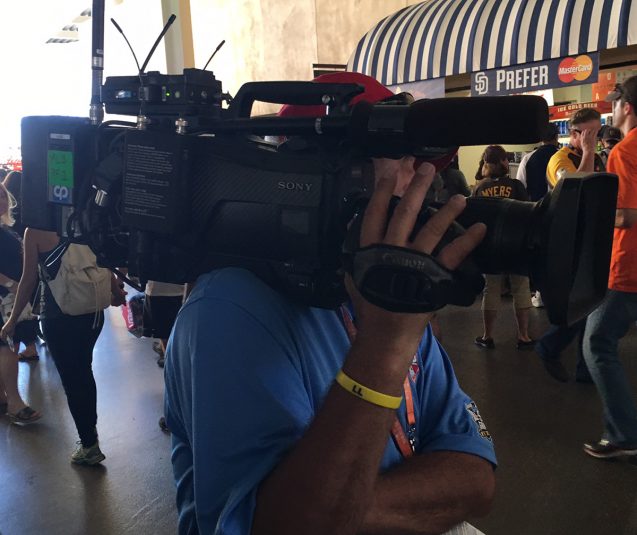
One of a dozen RF cameras deployed by CP Communications at MLB All-Star
“One of the challenges of [the in-ground microphones] is obviously to get everything working ahead of time because, once the mics are in the ground, you really have very little control over them,” said CP Communications President Michael Mason. “You get to turn them on, and that’s about it; you’re not going to get to go dig it up and replace it if something happens to that microphone. We were able to get ahead of it, and we couldn’t be happier with how it turned out.”
CP Communications also worked with MLB Network to create new portable fiber racks for its three-camera on-field set to streamline setup and strike.
“MLB Net knew exactly what they wanted. We conceptualized, drew it out, and engineers from our office put the cart together,” said Mason. “It does three cameras right now, but we can put up to six. It just depends on how we populate it.”
CP Communications provided three RF cameras, one a Steadicam, to ESPN for its Derby coverage and two handhelds and support for the HatCam to MLB Network.
Fox Sports deployed seven CP Communications RF cameras, including a roving Flare 4KSDI camera on a MōVI three-axis gimbal. The first-ever use of a Flare 4KSDI unit in this broadcast-centric configuration created a unique challenge for CP.
“It has a totally custom-designed interface for control that was built and designed in our shop,” says Mason. “Our system gives the video operators the same type of control that they would have on a regular TV camera. The Flare is really not a broadcast camera in any way, shape, or form, but this [provides] the same interface that you would have with a Sony or Grass Valley camera. It was a lot of work from the software to the hardware manufacturing, and all the inner connectivity in the MōVI rig itself was built in our shop. It took our engineers four to six months to get it all perfect, and they did a great job.”
Filmwerks
Filmwerks sets once again played a major part in the All-Star festivities. The vendor designed and manufactured Fox Sports’ primary set and both MLB Network sets at Petco Park.
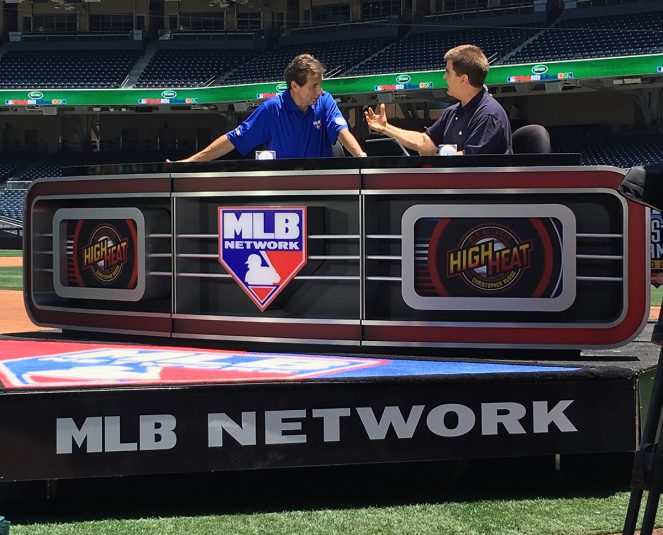
MLB Network primary set, which is wheeled on and off the field on a golf cart, is on the third-base line.
Fox Sports’ 20×20-foot set was similar to last year’s and located on the main concourse in centerfield near the Park at the Park. Thanks to the flexible ModTruss technology used to build Filmwerks sets, the Fox set’s roof could be collapsed and lowered in just 30 seconds after the pregame show concluded and before first pitch of the All-Star Game.
“With the ModTruss technology, two center columns are all that is needed to support the weight, and it’s hydraulically driven,” explained Filmwerks Lead Field Technician Curtis Voigt. “It ends up being a pretty simple process to lower it, and the whole set just comes right down.”
Filmwerks also provided MLB Network’s primary set on the field and secondary set on the concourse level. The primary set has become a staple for the network and resides on a motorized cart to allow a quick strike 30 minutes before first pitch of the Derby and the All-Star Game. As a result, MLB Network is capable of getting the entire set off the field in just five minutes.
“It’s a fully automated, self-propelled set that we developed over the past couple of years to assist in getting us off the field quicker, because we only have about seven minutes [between pregame show and game start],” said Voigt. “So we figured, if we could get it to drive with one person, instead of having everybody push it, we can speed up and have other people helping strike to make the process go a little quicker. We’re always looking for anything we can do to make it easier and keep improving, and we’ve done that this year.”
Fletcher Sports
Fletcher robotic and high-speed camera are always a fixture at the All-Star festivities, and this year was no different. The rental company provided four robos for Fox’s All-Star Game telecast and nine to ESPN for the Home Run Derby.
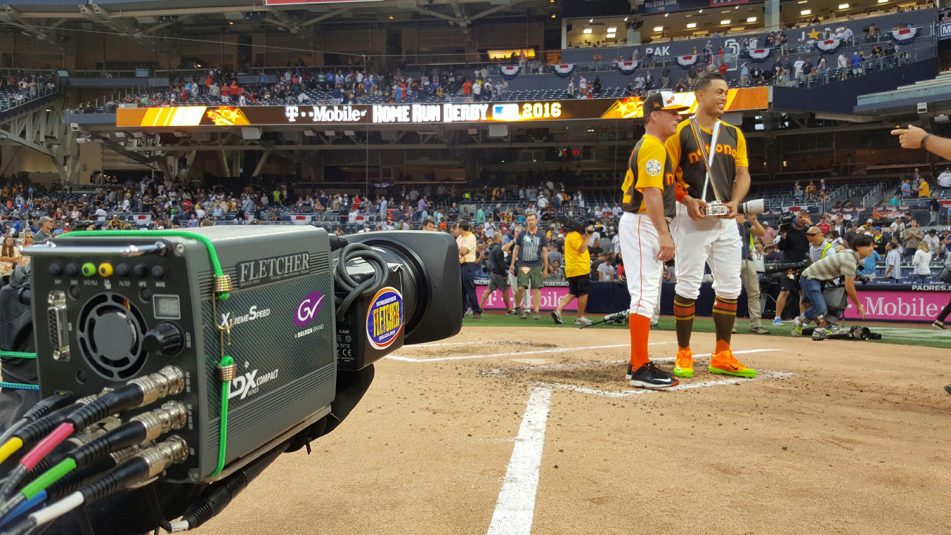
ESPN used a Grass Valley LDX 6X super-slo-mo as a robotic for the first time at the Derby just in front of home plate.
Chief among these systems was the debut of a Grass Valley LDX 6X slo-mo camera in a box-camera robotic configuration. The system was positioned directly in front of the hitter for ESPN’s Home Run Derby coverage and served as the mid-home backstop camera for Fox’s All-Star coverage.
“This is the same camera head that’s in the LDX 6X handheld, but now it’s a box-camera [configuration],” said Fletcher Chicago Manager Ed Andrzejewski. “We are able to do a 360-fps replay from the robo for a reasonable cost, which is a first. It’s not a high-speed camera that [the broadcaster] has to trigger and then play back; it can be continuous recording into a Grass Valley K2 Dyno, Evertz DreamCatcher, or EVS [replay server], which is great.”
Although YES Network has been using the camera for roughly two weeks on New York Yankees games, All-Star marked the system’s highest-profile use to date for baseball, following demos during the NHL Stanley Cup Playoffs and NBA Finals.
“We really believe that this Grass Valley LDX box camera is going to make a major splash this season,” said Andrzejewski. “We do a lot of different angles with the robotics, and it’s nice to finally bring an all-time-record high-speed camera on these robotic systems that’s actually affordable. This is something the market has been demanding, and we’re happy to now be able to provide it.”
Fletcher provided ESPN with nine robotic cameras, including the Grass Valley LDX 6X slo-mo, a Phantom ultra-high-speed camera (running at 1,600 fps), as well as robos in the booth and at low-first, low-third, over the pitcher’s shoulder, high-home, and two outfield positions. Fox deployed Fletcher robos at mid-home (LDX 6X slo-mo), high-home, and in both dugouts.
Sony
Sony’s HDC-4800 made its first-ever appearance on baseball coverage at Tuesday’s All-Star Game. Fox Sports deployed the 4K/ultra-high-frame-rate camera (with a 95X Canon lens) at low centerfield. The 4K ultra-high-speed camera’s 4K cutout capability allowed Fox to zoom in on a specific area of the game and slow it down while maintaining at least HD quality. During All-Star, the camera was used to capture close-up HD slo-mo images of the pitcher’s grip and rotation of the ball.
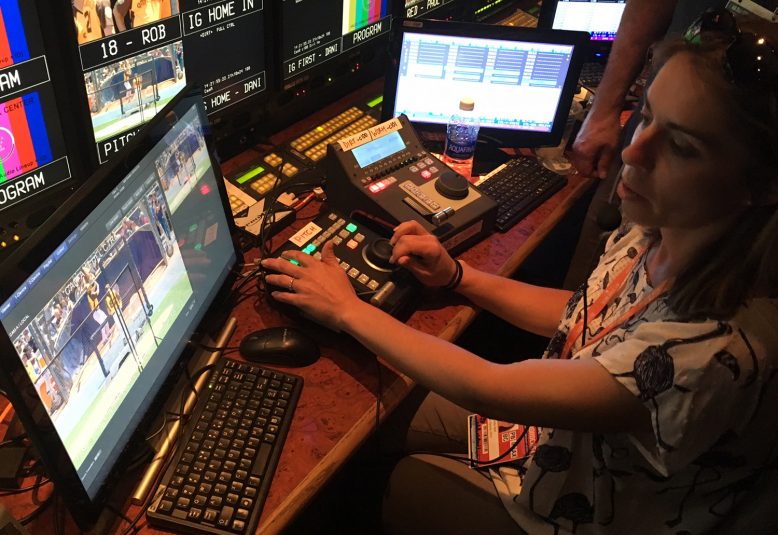
The Sony HDC-4800 replay operator station inside the Fox truck, which created 4K cutout replays of the pitcher grip and motion of the pitch
The HDC-4800 (one of only two currently available in North America) was used in tandem with the BPU-4800. The BPU-4800 is the companion baseband processing unit for the HDC-4800 and has a built-in two-channel server for replay and cutout operations. It uses a control interface similar to the Sony PWS-4500 production server.
“The HDC-4800 becomes a specialty camera, especially at that position, where it allows you to catch the batter as well as the motion of the pitcher,” said Deon LeCointe, senior manager, IP and sports, Sony Electronics. “Also, if you zoom out and turn the camera, you can catch the action at the bases. You might be able to determine, from a side angle, was the runner out at the base, and you’ll also be able to catch the movement of the ball as it goes into the catcher’s glove.”
ESPN and Fox also deployed multiple Sony HDC-4300’s as the primary game cameras and for ultra-slo-mo during the Home Run Derby and All-Star Game, respectively.
Sportvision
Sportvision was back at All-Star providing virtual-ad insertion for Fox Sports and Major League Baseball’s various foreign feeds — except with a new twist. In addition to virtual insertion behind home plate, Sportvision provided integrated virtual elements into Fox’s high-home camera (camera two) that were displayed over the Petco Park’s batters’ eye in centerfield.
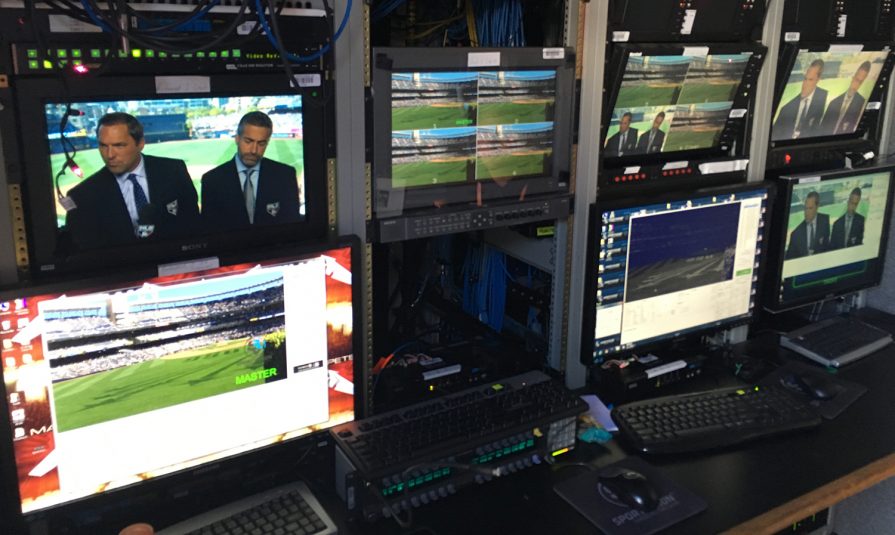
Inside one of two Sportvision vans onsite in San Diego
“It’s just like you would see behind home plate, except it appears on the batter’s eye and is using the high-home camera,” said Sportvision EVP/GM Ryan Zander. “We’ve certainly tested it in the past, but this will be the first time we’ve done it at a commercial big event like this. We’re leveraging similar technology that we use behind home plate, so it doesn’t present a [greater] technical challenge. You’ve obviously seen other sports with more [virtual] signage in different spots, so we’re happy to see that MLB and Fox are working with us to put this in a new area.”
